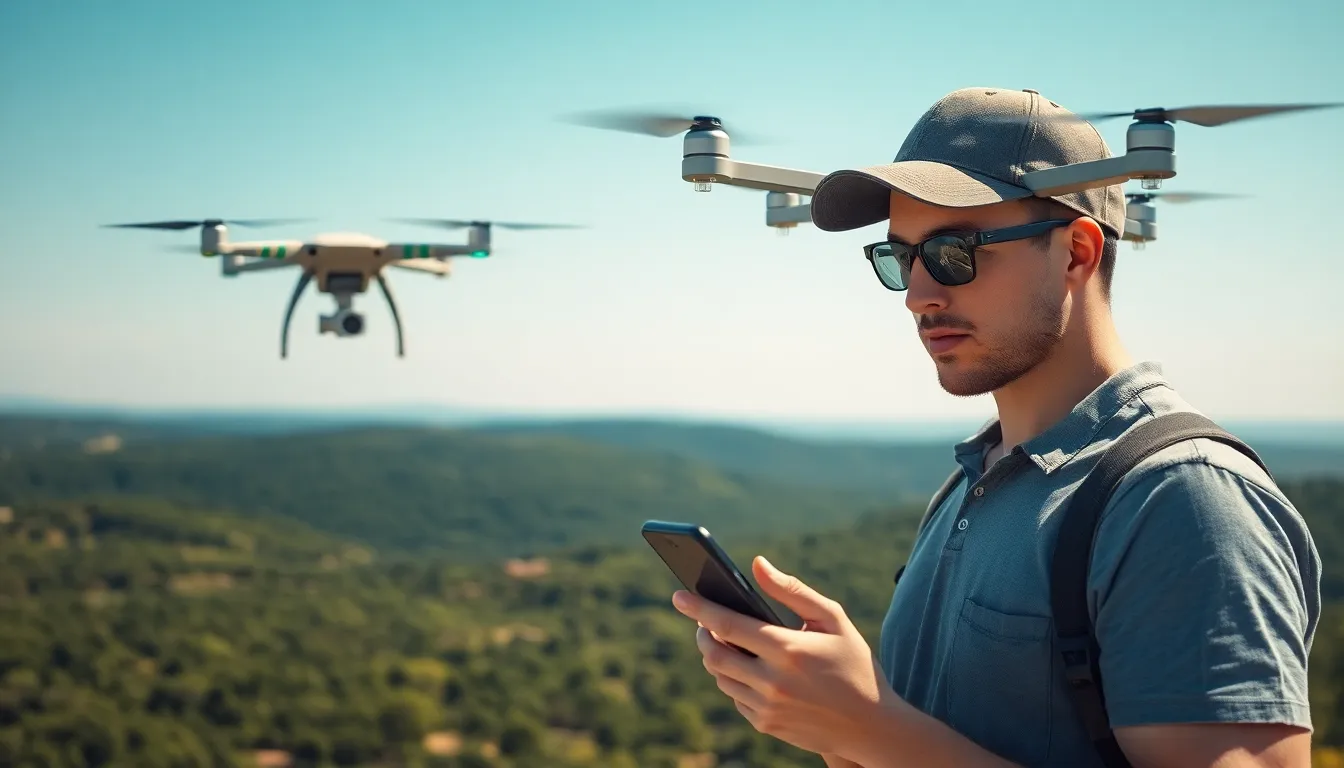In the rapidly evolving world of drone technology, effective flight planning has become essential for both hobbyists and professionals. Understanding how to navigate the skies safely and efficiently can make all the difference in achieving successful aerial missions. Whether capturing stunning landscapes or conducting critical inspections, proper planning ensures that each flight meets its objectives.
Drone flight planning encompasses more than just setting a destination. It involves assessing airspace regulations, weather conditions, and potential obstacles. With the right strategies and tools, operators can optimize their routes, conserve battery life, and enhance safety. As drones continue to play a pivotal role in various industries, mastering flight planning is not just an advantage—it’s a necessity.
Table of Contents
ToggleUnderstanding Drone Flight Planning
Effective drone flight planning ensures successful missions. Operators must analyze various factors for optimal performance and safety.
Importance of Flight Planning
Flight planning plays a vital role in ensuring efficient and safe operations. It enables operators to adhere to airspace regulations, monitor weather forecasts, and identify potential obstacles. By thoroughly planning, operators can reduce risks, enhance mission effectiveness, and optimize battery life. In sectors such as agriculture, construction, and surveying, structured flight plans facilitate data accuracy and operational efficiency, making them essential for professional applications.
Key Components of Flight Planning
Several components contribute significantly to successful flight planning:
- Airspace Regulations: Operators must identify restricted zones, no-fly areas, and altitude limits to comply with local laws and aviation guidelines.
- Weather Conditions: Analyzing real-time weather data helps operators avoid adverse conditions like high winds, precipitation, or low visibility that could jeopardize flight safety.
- Route Optimization: Using software tools or apps, operators can determine the most efficient flight paths, taking account of obstacles and minimizing travel time.
- Battery Management: Estimating power consumption based on distance and payload ensures that drones return safely without risking battery depletion.
- Emergency Procedures: Defining contingency plans for possible malfunctions or emergencies enhances operational safety and mitigates risks.
- Payload Considerations: Assessing the weight and type of equipment carried affects flight performance, so planning must account for load capacity.
By understanding and applying these components, operators can significantly improve their flight planning process.
Tools for Effective Drone Flight Planning

Effective drone flight planning relies on various tools that enhance mission success. These tools include both software options and hardware considerations that help operators navigate complex aerial environments.
Software Options
- Flight Planning Software: Apps like DJI Go and DroneDeploy streamline mission setup, offering features such as waypoint mapping, real-time weather updates, and automatic route optimization.
- Geospatial Analysis Tools: Software like ArcGIS provides detailed mapping options, allowing operators to analyze terrain and identify potential obstacles. These insights optimize flight paths.
- Regulatory Compliance Tools: Applications such as Airmap help ensure adherence to airspace regulations, offering alerts for no-fly zones and temporary flight restrictions, crucial for safe operations.
- Weather Monitoring Apps: Tools like Windy provide real-time weather data, offering wind speed, precipitation forecasts, and visibility conditions to assist in pre-flight assessments.
- Battery Management Software: Programs designed for battery monitoring track usage patterns, power levels, and flight times, allowing operators to maximize battery life effectively.
Hardware Considerations
- Autopilot Systems: Drones equipped with advanced autopilot systems enhance flight precision. These systems allow for automated flight paths that reduce human error during operations.
- GPS Modules: High-accuracy GPS units improve positional accuracy, which is essential for executing complex missions and avoiding no-fly zones.
- Obstacle Avoidance Sensors: Drones with built-in obstacle detection capabilities help in avoiding collisions, ensuring a safer flight experience in complex environments.
- Communication Systems: Reliable communication hardware, such as long-range transmitters, ensures consistent data transfer between the drone and the operator, critical for maneuvering in remote areas.
- Camera and Sensor Payloads: The right payload enhances data collection capabilities. Depending on the mission, operators can choose thermal cameras, multispectral sensors, or LiDAR equipment for specific applications.
Utilizing appropriate software and hardware tools streamlines the planning process, enhances safety measures, and ultimately leads to more successful drone operations.
Best Practices for Drone Flight Planning
Effective drone flight planning involves meticulous preparation and adherence to established protocols. Implementing best practices ensures safety, compliance, and mission success.
Pre-Flight Checklist
A pre-flight checklist is essential for verifying that all systems are operational before takeoff. Operators should confirm the following:
- Equipment Functionality: Inspect the drone’s motors, propellers, and camera systems for any damages or irregularities.
- Battery Status: Check the battery life of the drone and remote controller, ensuring adequate power for the entire mission.
- Firmware Updates: Ensure that the drone, batteries, and remote controller firmware are up-to-date for optimal performance and features.
- GPS Verification: Validate that GPS signals are strong, confirming accurate positioning during the flight.
- Flight Area Inspection: Assess the takeoff and landing zones for obstacles such as trees, buildings, and power lines to avoid accidents.
Completing this checklist minimizes operational risks and enhances flight reliability.
Regulatory Compliance
Understanding and adhering to airspace regulations is crucial for legal drone operations. Operators must:
- Review Local Laws: Research local regulations, including altitude limits, no-fly zones, and required permits.
- Notify Authorities: When flying in controlled airspace or higher altitudes, notify relevant aviation authorities to ensure compliance and safety.
- Register the Drone: In many countries, drones over a specific weight threshold require registration with aviation authorities.
- Inspect for Restrictions: Identify temporary flight restrictions (TFRs) due to events or emergencies that may impact the planned route.
Staying informed about regulatory requirements fosters safe, responsible drone usage and helps avoid legal complications.
Challenges in Drone Flight Planning
Drone flight planning faces various challenges that can hinder effective operations. Environmental factors and technical limitations play significant roles in these complexities.
Environmental Factors
Environmental factors introduce uncertainty in drone operations. Weather conditions affect flight safety and mission success. Wind speed exceeding 20 mph, heavy rain, fog, or snow reduces visibility and impacts drone stability. Additionally, obstacles like trees, buildings, and power lines pose significant risks during flight. Operators must regularly examine real-time weather data and environmental conditions, ensuring they select optimal times and routes for safe operations.
Technical Limitations
Technical limitations also complicate drone flight planning. Batteries have limited lifespans, typically lasting 20 to 30 minutes depending on the drone model and payload weight. Overloading a drone can shorten flight duration and increase the potential for malfunctions. GPS accuracy can be adversely affected in urban environments due to signal interference from tall structures. Moreover, software compatibility issues may arise when using multiple tools for planning and execution. Operators must stay updated with technological advancements and regularly maintain their drones to mitigate these challenges.
Future Trends in Drone Flight Planning
Innovations in drone flight planning are shaping the future of aerial operations. Automating mission planning processes stands out as a significant trend, with advanced algorithms streamlining route optimization. These algorithms analyze various factors, including real-time weather updates and airspace restrictions, ensuring safer, more efficient flights.
Harnessing artificial intelligence (AI) is another key development. AI can predict optimal flight paths by simulating various scenarios, enabling operators to anticipate potential challenges. This technology not only enhances precision but also allows for adaptive planning that accounts for dynamic environmental variables.
Integration of cloud computing into flight planning systems improves data accessibility. Operators can access up-to-date information from anywhere, facilitating collaborative mission planning. Utilizing cloud services ensures that teams operate with the latest regulations and weather data.
Growth in drone delivery services influences flight planning strategies. As commercial drone deliveries expand, planners must develop specialized routes that accommodate varying package sizes and weights. Adapting flight paths for efficiency while adhering to regulations becomes crucial.
Advancements in drone communications technology promote real-time data exchange. Utilizing 5G and other high-speed networks ensures that drones receive immediate updates on airspace changes and weather conditions. This capability improves situational awareness during flights, enhancing overall safety.
Emphasizing enhanced safety protocols, future flight planning tools will likely incorporate more robust emergency management features. These tools can facilitate automatic return-to-home processes or rerouting based on immediate threats, ensuring operator safety and compliance with regulations.
Exploring the potential of augmented reality (AR) in flight planning offers a new dimension for operators. AR applications can provide visual overlays of airspace restrictions, obstacles, and other relevant data directly in the pilot’s field of view. This technology fosters informed decision-making during missions.
Incorporating drone-to-drone communication systems will lead to more sophisticated fleet operations. These systems allow drones to share information about their surroundings, enhancing coordination and minimizing collision risks. Implementing such systems will transform how drones perform in various applications, from agriculture to emergency response.
Ultimately, staying ahead of these trends requires operators to continuously adapt their flight planning strategies. Engaging with emerging technologies and remaining informed about industry advancements will enhance operational effectiveness and ensure compliance with evolving regulations.
Effective drone flight planning is vital for successful aerial operations. By prioritizing safety and compliance with regulations, operators can navigate challenges and optimize their missions. Utilizing advanced tools and best practices enhances both efficiency and effectiveness.
As the drone industry continues to evolve, staying updated on technological advancements and emerging trends is essential. Embracing automation and AI will further refine flight planning processes. Ultimately, thorough preparation and adaptability will ensure that drone operators can meet the demands of various sectors while maximizing safety and operational success.




